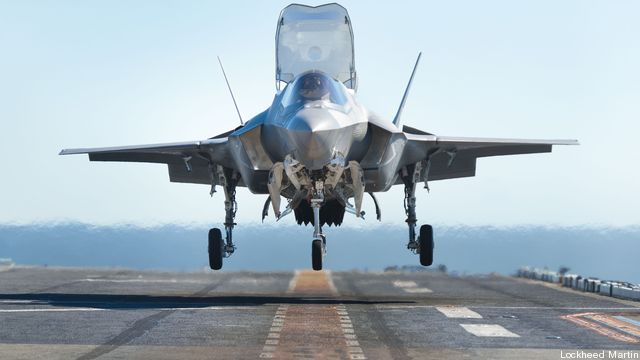F-35 Starts Climb To Get Back On Track; SecDef Lifts F-35B Probation
Posted on

PATUXENT RIVER NAVAL AIR STATION: Lockheed Martin’s Joint Strike Fighter program is on track to get back on track. The road ahead is long and bound to be bumpy, but after at least two years of almost unremittingly bad news, the program now can claim several important achievements. That seemed to be Defense Secretary Leon Panetta’s larger message from his extraordinary visit to the F-35’s test center here today.
The most topical achievement: Defense Secretary Leon Panetta today removed the Marines F-35B from the probation imposed by his predecessor one year ago. While it’s hard to tell what practical effect this status ever had on the program, it was an important optical that shaped how the program — targeted by defense spending critics for elimination — was perceived by Congress, analysts, the Marines and the the other services.
Less obvious, but probably more significant in the long term, is the marked shift in the tone of remarks by senior defense officials — from Panetta on down — since the departure of former Defense Secretary Robert Gates.
One factor behind the the SecDef’s lifting of probation appears to be an unnamed capability. A senior defense official said that the B variant of the Joint Strike Fighter shares a capability with the Harrier — the aging British-built STOVL aircraft — that is important to counterrorism. Panetta, of course, came to the Pentagon from his job as CIA Director, where counterrorism was the focus of most of his waking hours.
The senior official said “there is a certain capability that Harriers provide,” one “That’s certainly made an impression on him [Panetta] in terms of the B variant.” This capability has been used in the Middle East and other parts of the world. That was as specific as the senior official would get.
So, given the positive news about the F-35B, and Panetta’s statements today that the Joint Strike Fighter is “vital” to U.S. anti-access capabilities (smile, China) and is “absolutely vital to maintaining our air superiority,” I asked Panetta’s spokesman, George Little, if the program has undergone an important shift over the last year and is in markedly better shape. Little’s response was cautious.
“We believe that it is going to take some time,” Little said. “We are going to have work through issues. Progress is being made, but if we see the same progress we are seeing today then we are going to get across the goal line. it is not going to be overnight, but we are going to get there.”
In his speech to the 150 or so people in the crowd — program officials, test pilots, local politicians, industry folk and assorted hangers-on — Panetta offered a kind word to the JSF community. “We now believe that because of your work, that the [F-35B] variant is demonstrating the kind of performance and maturity that is in line with the other two variants of the JSF,” he said.
Add all of that together, and what you have is a much different tone than one would have heard from the Gates Pentagon only one year ago. It doesn’t mean the Pentagon, pressed hard for spending cuts, won’t slice the planned JSF budget for the next five years, but it may mean the overall number of F-35s won’t change that much. After all, the head of the JSF program, Vice Adm. David Venlet has already told AOL D readers that, “it’s wise to sort of temper production for a while.”
Subscribe to our newsletter
Promotions, new products and sales. Directly to your inbox.
